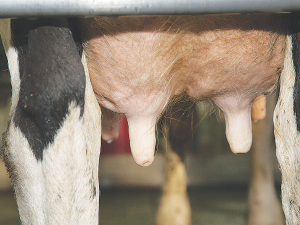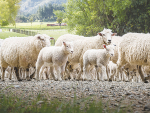Properly detecting mastitis is a very important part of both control and treatment.
Infected cows pose a risk to other cows in the herd, as their infection can be spread quickly to other cows via the milking machines and udder handling by staff.
Infected cows left untreated produce less and less milk, and if the infection gets into the deeper tissues there is long term damage to the udder. Not only this, but the infection gets progressively harder to treat. If the cow develops a chronic (long term) infection, her somatic cell count may rise, increasing the risk of culling and decreasing her value for sale.
Most mastitis is moderate. There is some clotting or discolouration of the milk, but the rest of the body is unaffected. All mastitis enters via teat, and can only be passed between quarters via the milking machine or the hands of the assistant.
Lumps appear in the milk due to pH change, tissue debris and inflammatory fluid. The milk may become watery, bloody and even smelly. The changes can range from severe to mild, but is considered clinical if visible or subclinical if invisible but smouldering away. Further milk tests may be required to clarify infection status. These may be the likes of a Rapid Mastitis Test (RMT) which breaks up the DNA of bacterial and pus cells and makes it clot, giving a thick gel when infection is present.
Mastitis can be found at any stage of lactation, including the dry period. Swollen quarters or hind leg lameness can be a giveaway. In these cases, only strip the quarter if it is hot and painful, otherwise you may be losing the keratin plug for no good cause.
As most mastitis occurs around calving, good colostrum mob mastitis detection can nip problems in the bud. This mob can become a quarantine mechanism, with only clean cows entering the main milking herd. Stripping daily to examine the milk and a further close examination (possibly including RMT or conductivity) as cows exit the colostrum mob should be done, and affected cows either monitored or treated.
If cows are to be treated, a milk sample can be taken prior and frozen. This can be cultured if necessary down the track for useful information. Strip treated cows just after the end of treatment and again at the end of the drug withholding period.
For the first 6-8 weeks, a weekly strip is advised or strip targeted cows after herd test or whenever the filter sock gets clots. If things are going well after that, milking staff remaining vigilant for swollen or sore quarters may be all you need.
Types of Mastitis
Mastitis is also classified as clinical mastitis (disease with visible changes in the milk) and subclinical mastitis (disease that is not visibly apparent).
The great majority of cases are subclinical. Because it is not obvious, dairy producers may not be aware of subclinical mastitis and the extent of lost milk production that results. Undetected subclinical mastitis can also be a source of infection to other cows, will elevate Somatic Cell Count (SCC) and decrease production.
Clinical mastitis is characterised by the following:
- Rapid onset, heat, swelling, reddening, or hardening of infected quarters. This is painful.
- Visible abnormalities in milk, including clots, flakes, or discolouration.
- In acute cases systemic signs, including fever, anorexia and reduced rumination, dehydration, weakness, depression, and noticeable decline in milk production.
- The cow may be lame due to swelling of the udder.
- Subclinical mastitis is characterised by the following.
- No visible change in the udder or in appearance of the cow.
- No visible abnormalities in milk.
- Reduced milk yield in the affected quarter(s).
- In some cases, periodic episodes of clinical mastitis in affected cows.
- Elevated SCC and BTSCC.


















